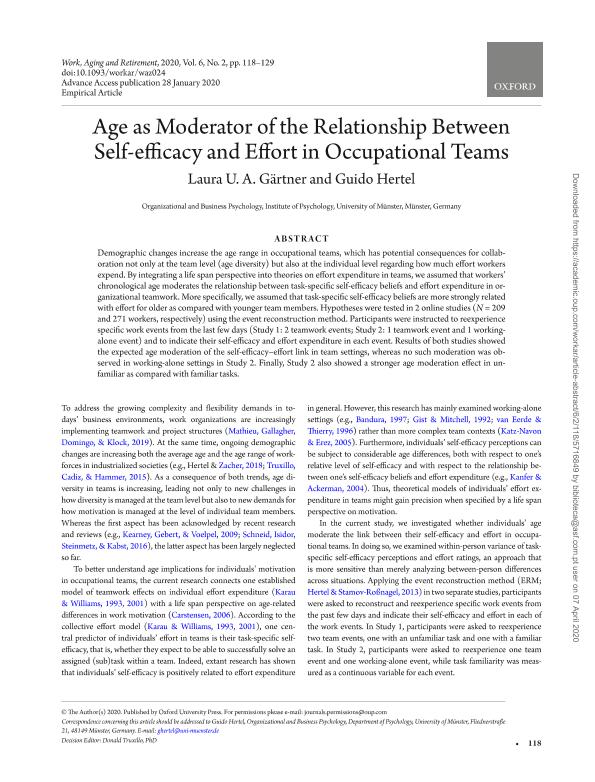Age as moderator of the relationship between self-efficacy and effort in occupational teams

Contenido multimedia no disponible por derechos de autor o por acceso restringido. Contacte con la institución para más información.
| Tag | 1 | 2 | Value |
|---|---|---|---|
| LDR | 00000cab a22000004b 4500 | ||
| 001 | MAP20200011514 | ||
| 003 | MAP | ||
| 005 | 20200407162853.0 | ||
| 008 | 200407e20200401gbr|| p |0|||b|eng d | ||
| 040 | $aMAP$bspa$dMAP | ||
| 084 | $a922.3 | ||
| 100 | 1 | $0MAPA20200007463$aGärtner, Laura U. A. | |
| 245 | 1 | 0 | $aAge as moderator of the relationship between self-efficacy and effort in occupational teams $cLaura U. A. Gärtner and Guido Hertel |
| 520 | $aThis research contributes to the existing literature in three ways. First, to our knowledge this is the first study that empirically examines ages differences in the relationship between event-specific self efficacy and effort in teamwork contexts; as such, we answer recent calls to examine age differences in teamwork contexts at the level of the individual member (Gärtner, Nohe, & Hertel,2019; Rudolph & Zacher, 2015). Second, we considered task familiarity and work context (i.e., teamwork vs. working alone) as additional moderators of the event -specific self-efficacy-effort link to achieve a more precise prediction of age differences in team-related effort expenditure. Whereas extant research has considered task characteristics with implications for age-related cognitive capabilities (e.g., Kanfer & Ackerman, 2004), the current research considers task characteristics with implications for age-related social processes. Third, this study provides new suggestions for HR management to address challenges posed by demographic changes at the level of the individual worker (e.g., Hertel & Zacher, 2018), for instance, with respect to staffing or task assignments in occupational teams | ||
| 650 | 4 | $0MAPA20080621452$aGestión de recursos humanos | |
| 650 | 4 | $0MAPA20080625139$aTransformaciones demográficas | |
| 650 | 4 | $0MAPA20080585051$aEquipos de trabajo | |
| 650 | 4 | $0MAPA20080598662$aRelaciones laborales | |
| 700 | 1 | $0MAPA20200007470$aHertel, Guido | |
| 773 | 0 | $tWork, aging and retirement - Oxford : Oxford Academic$gV. 6, n.º 2 (april 2020) p. 118-129 |

